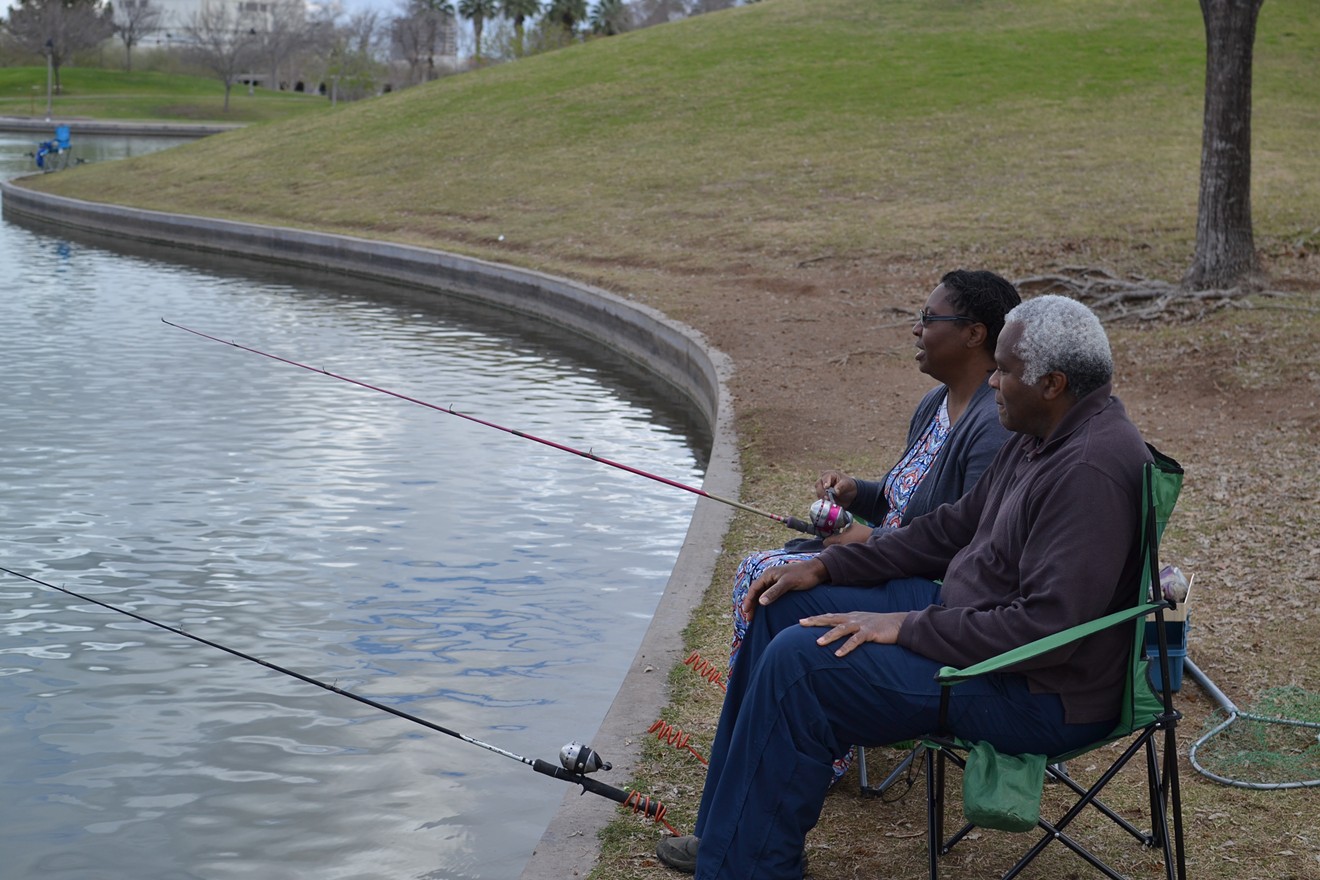Steven and Emily Rainge like to go to the pond at Steele Indian School Park every few weeks, at least. They set up their bright-green folding chairs and rod holders, put putty on the hooks (if they're fishing for trout), and sit back. Whatever they catch, they bring home to eat or store in the freezer.
"We just like fishing, and the fish is fresher, coming out of here," Emily said on Tuesday afternoon as she stood next to the pond. "I feel safe eating them because they come from stock ponds. The water in here is not too bad."
Some local scientists and researchers are not so sure about that.
Marine biologist Beth Polidoro and a team of students in her lab at Arizona State University have spent the past five years taking water samples and catching fish from urban ponds and lakes across the Valley. They've tested both samples for contaminants, and so far, in a pilot study, they've found that the fish contain varying concentrations of pesticides, other chemicals, and metals including mercury and arsenic.
To Polidoro, their findings were worrisome. Some of the species were born in a hatchery and stocked in the lakes. Others were native residents. Given the small sample size, the results showed a clear need for more research and monitoring, and for the state to start paying more attention to these pollutants, which she worried could have a disproportionate impact on people in minority or impoverished communities.
If you want to go fishing in metro Phoenix, you have 28 community fishing areas to choose from. The Arizona Game and Fish Department stocks these urban lakes and ponds as part of a statewide community fishing program. Depending on the season, ponds will be full with trout, bluegill, bass, or catfish. The ponds also have a few full-time resident species, like sunfish and common carp.
In a previous study, Polidoro and two colleagues found that many of these sites in Phoenix were in low-income and minority neighborhoods. And when they surveyed anglers at these ponds, they found that nearly 60 percent said they ate the fish they caught or shared it with friends and family.
“It’s an economical, very cheap source of protein,” Polidoro said, noting that a permit to fish in these areas costs $15 a year. She began studying the fish because “no one really was monitoring contaminants in the surface waters in Phoenix, and also not in the fish."
For the pilot study, the undergraduate students in Polidoro's lab went fishing at 11 of these ponds and lakes across the Valley, including the pond at Steele Indian School Park where the Rainges like to fish. They caught 21 fish ("I think we could get better at fishing," Polidoro said) and extracted five-gram samples of flesh from them. They blended the flesh to a pulp and mixed the samples with different chemicals, then analyzed them for contaminants using a gas chromatograph and a mass spectrometer.
The resident sunfish, it turned out, had far more more contaminants than the stocked trout, bluegill, catfish, and bass tested.
Sunfish had the highest concentration by far of phthalates, a class of chemicals of which one type is potentially carcinogenic. Some groups of phthalates have been banned in the European Union since 1999. The sunfish edged out bass in containing the most polycyclic aromatic hydrocarbons, a group of chemicals found in smoke and vehicle exhaust.
The sunfish flesh also contained five different pesticides, including DDE, a cousin of the notorious DDT. No other species except trout contained any pesticides at all, they found.
All of the fish in the study had varying levels of mercury, which is normal, to an extent. Almost all fish, including what you buy at the grocery store, contain traces of the harmful metal, some in more dangerous quantities than others. One fish in the pilot study, a bluegill from Rio Vista pond in Peoria, had levels of mercury that exceeded the federally recommended level of 0.15 parts per million. Nearly all of the fish in the study had levels of aluminum that exceeded the level recommended by the Environmental Protection Agency.
"I did expect to find some contaminants, but not of the variety and concentrations that we did," said Daniel Lucas, a freshman now at the University of Arizona who co-authored the study with Polidoro. "I'm amazed at the serious public health implications that this poses."
The fact that the resident fish had greater concentrations of pollutants than the stocked fish suggests that those contaminants are probably coming from their surrounding environments — the water, the grass, the soil, the garbage, or something else.
Polidoro is now working to write the results of her analysis on the water quality samples her team took, which she said was more extensive than the 21 fish her team caught. After that, they'll be looking for more funding to continue their study, since the funding they got from the EPA and National Fish and Wildlife Service ended a few months ago.
As for the source of the pollutants in the stocked fish, "that's something we really don't know," Polidoro said. "It’s ... very difficult to know whether the contaminants in those fish came from living in Phoenix lakes and ponds, or the hatchery, or the food they were fed at the hatchery. It’s almost impossible to know without going to the hatchery."
Asked whether he would eat a fish from a pond in metro Phoenix, Lucas said, "Absolutely not."
In 2013, about 85,000 people took to urban fishing spots across Arizona. Game and Fish aims for its community fishing program to reach 200,000 people by 2025, in large part by adding fishing locations in canals owned by Salt River Project, the Central Arizona Project, and irrigation companies.
And while the Arizona Department of Environmental Quality analyzes fish in a handful of these locations for common toxins like mercury, a lot more of them are going untested.
The ADEQ tests fish from 15 to 20 streams and lakes, looking for mercury, polychlorinated biphenyls (PCBs), and other pollutants "that may be harmful to public health and the environment," it says. But it's not clear how frequently it does so. Nor is the department responsible for monitoring the artificial lakes and ponds that comprise many of the community fishing spots. According to Polidoro, some cities monitor those waters for algae, but not for metals, pesticides, or other toxins.
The department's most recent public Fish Consumption Advisories, which anglers can access online, currently contain warnings only regarding mercury, and only in the waters that the department monitors.
Erin Jordan, ADEQ spokesperson, said the department needed time to review the study. Nick Walter, a spokesperson for Game and Fish, said his agency was also reviewing the study.
As for Steven and Emily Rainge, they plan to keep fishing at the pond at Steele Indian School Park.
"It wouldn't change my mind, unless it's something that's worse than the fish that's in the store," Emily said, after hearing about the pilot study.
The pilot study did not compare contaminant levels in fish from urban ponds with those in fish you buy in the supermarket. Some studies have found contaminants in commercially bought, farmed salmon and low levels of heavy metals in a range of commercial fish and shellfish. However, another concluded that the benefits of eating fish outweighed the risks of consuming contaminants, at certain levels.
Steven took a smudge of green putty, i.e. trout bait, and dabbed it on his hook. He wiped his fingers on the grass.
"It's nasty," he said, then cracked a joke. "That's probably what's contaminating the water."
[
{
"name": "Air - MediumRectangle - Inline Content - Mobile Display Size",
"component": "18478561",
"insertPoint": "2",
"requiredCountToDisplay": "2"
},{
"name": "Editor Picks",
"component": "16759093",
"insertPoint": "4",
"requiredCountToDisplay": "1"
},{
"name": "Inline Links",
"component": "17980324",
"insertPoint": "8th",
"startingPoint": 8,
"requiredCountToDisplay": "7",
"maxInsertions": 25
},{
"name": "Air - MediumRectangle - Combo - Inline Content",
"component": "16759092",
"insertPoint": "8th",
"startingPoint": 8,
"requiredCountToDisplay": "7",
"maxInsertions": 25
},{
"name": "Inline Links",
"component": "17980324",
"insertPoint": "8th",
"startingPoint": 12,
"requiredCountToDisplay": "11",
"maxInsertions": 24
},{
"name": "Air - Leaderboard Tower - Combo - Inline Content",
"component": "16759094",
"insertPoint": "8th",
"startingPoint": 12,
"requiredCountToDisplay": "11",
"maxInsertions": 24
}
]













